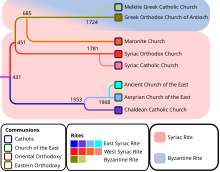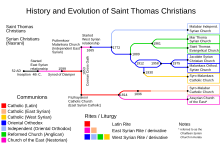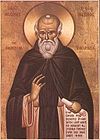Liturgical calendar of the Syro-Malabar Catholic Church
The Syro-Malabar Church is a Catholic Church sui iuris of the East Syriac Rite that adheres to the following calendar for the church's liturgical year. Like other liturgical calendars, the Syro-Malabar calendar loosely follows the sequence of pivotal events in the life of Jesus.[1]
Liturgical seasons[]
The Syro-Malabar liturgical year opens with the season of Annunciation, which begins on the Sunday between November 27 and December 3. This day corresponds to the First Sunday of Advent in the Western Roman Rite tradition.
The liturgical year is divided into the following nine seasons.[1]
| Season | Start Date | Duration | |
|---|---|---|---|
| 1 | Annunciation (Suvara) | The Sunday between November 27 and December 3 | 3–4 weeks |
| 2 | Nativity | December 25 | 1–2 weeks |
| 3 | Epiphany (Denha) | The Sunday between January 2 and 6; otherwise January 6, if no such Sunday exists | 4–9 weeks |
| 4 | Great Fast (Sawma Rabba) | The 7th Sunday before Easter[note 1] | 7 weeks |
| 5 | Resurrection (Qyamta) | Easter Sunday | 7 weeks |
| 6 | Apostles (Slihe) | Pentecost Sunday (the 7th Sunday after Easter) | 7 weeks |
| 7 | Summer (Qaita) | The 7th Sunday after Pentecost | 7 weeks |
| 8 | The 14th Sunday after Pentecost | 6–11 weeks | |
| 9 | The Sunday between October 30 and November 5 | 4 weeks |
Although the eighth season (Elijah–Cross–Moses) is considered one of the nine, it is also regarded as a combination of the three distinct seasons that are named (Elijah, Cross, and Moses).[2]
Variable feast days[]
The following feast days are fixed to a particular weekday, rather than a particular calendar day.
| Feast | Date |
|---|---|
| The Divine Motherhood of Mary | The Friday between December 30 and January 5 |
| St. John the Baptist | The first Friday of Epiphany (the Friday between January 7 and 13) |
| Sts. Peter and Paul | The second Friday of Epiphany (the Friday between January 14 and 20) |
| The Evangelists | The third Friday of Epiphany (the Friday between January 21 and 27) |
| St. Stephen | The fourth Friday of Epiphany (the Friday between January 28 and February 3) |
| The Greek Fathers | The fifth Friday of Epiphany (the Friday between February 4 and February 10) |
| The Syriac Fathers | The third Friday before Lent[note 2] |
| The Patron of the Church | The second Friday before Lent[note 3] |
| Commemoration of the Dead | The Friday before Lent |
| Palm Sunday | The Sunday before Easter |
| Pesaha Thursday | The Thursday before Easter |
| Passion Friday | The Friday before Easter |
| Great Saturday | The Saturday before Easter |
| Easter Sunday | |
| Feast of Martyrs (All Saints) | The Friday after Easter |
| Saint Addai | The Fifth Sunday of Resurrection (the fourth Sunday after Easter) |
| Ascension of Our Lord | The sixth Thursday after Easter |
| Pentecost | The First Sunday of Apostles (the seventh Sunday after Easter) |
| Friday after the First Sunday of Apostles | |
| The Holy Trinity | The Second Sunday of Apostles |
| The Body and Blood of Christ | Thursday after the Second Sunday of Apostles |
| Sacred Heart of Jesus | Friday after the Third Sunday of Apostles |
| Immaculate Heart of Mary | Saturday after the Third Sunday of Apostles |
| Seventy disciples of Jesus | Friday after the Seventh Sunday of Apostles |
| Twelve Apostles | First Sunday of Summer |
| St. James of Nisibis | Friday after the First Sunday of Summer |
| St. Mari | Friday after the Second Sunday of Summer |
| St. Simoni and seven sons | Friday after the Fifth Sunday of Summer |
| St. Simon Barsaba and co-martyrs | Friday after the Sixth Sunday of Summer |
| Mission Sunday | Seventh Sunday of Elijah–Cross–Moses |
| The Dedication of the Church | First Sunday of the Dedication of the Church |
| Christ the King | Fourth Sunday of the Dedication of the Church |
| The Holy Family | The Sunday between December 25 and 31 |
Fixed feast days[]
The 19 feast days marked with an asterisk (*) are commemorations found in the Appendix of the Syro-Malabar liturgical calendar.[3]
January[]
- 1: The Holy Name of Jesus and the Circumcision
- 1: New Year's Day
- 3: St. Kuriakose Elias
- 6: Epiphany
- 20: St. Sebastian
- 21: St. Agnes*
- 24: St. Francis de Sales
- 25: The Conversion of St. Paul
- 26: Sts. Timothy and Titus
- 26: Republic Day
- 28: St. Thomas Aquinas
- 30: World Day of Peace
- 31: St. John Bosco
February[]
- 2: The Presentation of the Lord and Purification of Our Lady
- 4: St. John Britto
- 11: Our Lady of Lourdes
- 14: Sts. Cyril and Methodius*
- 23: St. Polycarp
- 25: Bl. Rani Maria
March[]
- 18: St. Cyril of Jerusalem
- 19: The Death of St. Joseph
- 25: The Annunciation
April[]
- 24: St. George
- 25: St. Mark the Evangelist
- 29: St. Catherine of Sienna
May[]
- 1: St. Joseph, Patron of the Working Class
- 2: St. Athanasius
- 3: Sts. Philip and James, Apostles
- 6: St. Dominic Savio
- 14: St. Mathias the Apostle
- 16: St. Simon Stock*
- 23: St. Rita*
- 31: Visitation of the Blessed Virgin Mary
June[]
- 1: St. Justin
- 8: St. Mariam Thresia
- 9: St. Aprem
- 11: St. Barnabas
- 13: St. Antony of Padua
- 17: Sts. Gervasis and Prothasis*
- 21: St. Alosius Gonsaga*
- 22: Sts. John Fisher and Thomas More
- 24: Birth of John the Baptist
- 28: St. Irenaeus
- 29: Sts. Peter and Paul, Apostles
July[]
- 3: St. Thomas the Apostle
- 6: St. Maria Goretti*
- 11: St. Benedict
- 15: Sts. Kuriakose and Julitta
- 16: Our Lady of Mount Carmel
- 22: St. Mary Magdalene
- 25: St. James the Apostle
- 26: Sts. Joachim and Anne
- 28: St. Alphonsa
- 29: St. Martha
- 31: St. Ignatius of Loyola
August[]
- 1: St. Alphonse Liguori
- 4: St. John Maria Vianney
- 6: Transfiguration of Our Lord
- 8: St. Dominic
- 10: St. Lawrence*
- 11: St. Clare
- 13: St. John Berchmans*
- 14: St. Maximilian Kolbe
- 15: Assumption of Our Lady
- 15: Independence Day
- 20: St. Bernard*
- 21: St. Pius X
- 24: St. Bartholomew the Apostle
- 27: St. Monica*
- 28: St. Augustine
- 29: St. Euphrasia
September[]
- 3: St. Gregory the Great*
- 5: St. Theresa of Calcutta
- 8: The Nativity of Our Lady
- 13: St. John Chrysostom
- 14: The Exaltation of the Cross
- 21: St. Mathew the Apostle
- 27: St. Vincent de Paul
- 29: Archangels Michael, Gabriel, and Raphael
- 30: St. Jerome
October[]
- 1: St. Therese of the Child Jesus
- 2: Guardian Angels
- 4: St. Francis of Assisi
- 7: Queen of the Rosary*
- 15: St. Theresa of Avila
- 16: Bl. Thevarparampil Kunjachan
- 17: St. Ignatius of Antioch
- 18: St. Luke the Evangelist
- 22: St. John Paul II
- 28: Sts. Simon and Jude, Apostles
November[]
- 1: All Saints
- 2: Commemoration of the Dead
- 3: St. Martin de Porres*
- 5: Sts. Zachariah and Elizabeth
- 10: St. Leo the Great*
- 15: St. Albert the Great*
- 21: Dedication of Holy Mother Mary*
- 30: St. Andrew the Apostle
December[]
- 3: St. Francis Xavier
- 4: St. John Damascene*
- 5: St. Sabba*
- 7: St. Ambrose
- 8: The Immaculate Conception of Our Lady
- 14: St. John of the Cross
- 18: The Miraculous Cross at Mylapore
- 25: Christmas
- 26: St. Stephen
- 27: St. John the Apostle
- 28: Holy Childhood Day
Holy days of obligation[]
In the Syro-Malabar Church, there are 6 holy days of obligation:[4]
- Epiphany (January 6)
- Sts. Peter and Paul (June 29)
- The Ascension of Our Lord (sixth Thursday after Easter)
- St. Thomas (July 3)
- The Assumption of the Blessed Virgin Mary (August 15)
- Christmas (December 25)
Periods of fasting[]
The Syro-Malabar Church proposes the following days of fasting to the faithful.[5][6]
| Name | Dates |
|---|---|
| 25 Days' Lent | December 1–24 |
| Three Days' Lent | The third Monday, Tuesday, and Wednesday before the beginning of Lent |
| Great Lent | The first Monday of Lent through Holy Saturday |
| Fifteen Days' Lent | August 1–14 |
| Eight Days' Lent | September 1–7 |
See also[]
- Saint Thomas Christians
- Knanaya
- Syro-Malankara Catholic Church
References[]
- ^ a b Syro-Malabar Major Archiepiscopal Commission for Liturgy. "Syro-Malabar Liturgical Calendar: 2020–2021" (PDF). p. 3.
- ^ Syro-Malabar Major Archiepiscopal Commission for Liturgy. "Syro-Malabar Liturgical Calendar: 2020–2021" (PDF). pp. 50–58.
- ^ Syro-Malabar Major Archiepiscopal Commission for Liturgy. "Syro-Malabar Liturgical Calendar: 2020–2021" (PDF). p. 68.
- ^ Syro-Malabar Major Archiepiscopal Commission for Liturgy. "Syro-Malabar Liturgical Calendar: 2020–2021" (PDF). p. 5.
- ^ Syro-Malabar Major Archiepiscopal Commission for Liturgy. "Syro-Malabar Liturgical Calendar: 2020–2021" (PDF). p. 4.
- ^ Syro-Malabar Major Archiepiscopal Commission for Liturgy. "Syro-Malabar Liturgical Calendar: 2020–2021" (PDF). p. 19.
Notes[]
- ^ In the Syro-Malabar calendar, Lent starts one week earlier than it does in the Roman Rite tradition.
- ^ In years in which the First Sunday of Lent falls on February 26 or earlier, this feast is transferred to a later Friday.
- ^ In years in which the First Sunday of Lent falls on February 19 or earlier, this feast is transferred to a later Friday.
External links[]
- Syro-Malabar Catholic Church
- Liturgical calendars of the Catholic Church
- Time in India


